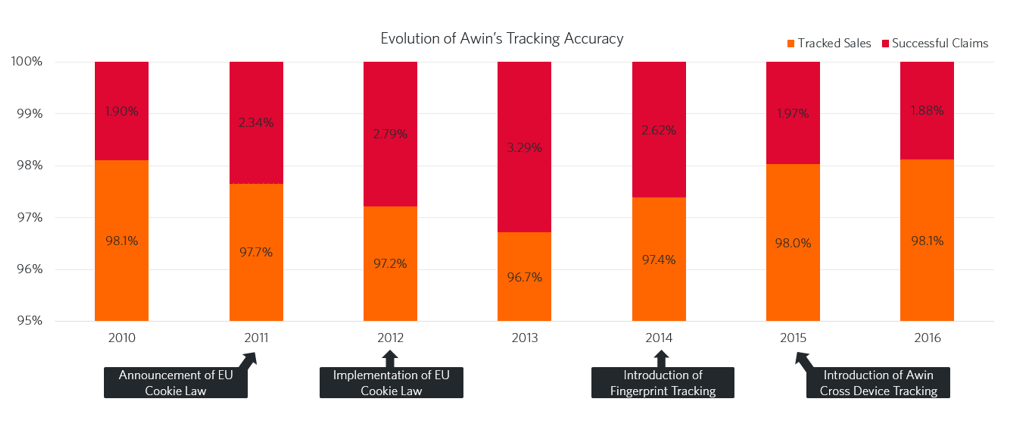It’s important to understand how we measure accuracy, how accurate the tracking actually is and more importantly what impacts its accuracy.
It is not an exact science to measure accuracy but our natural starting point is to look at cashback and loyalty sites. Both these publisher types have customers who raise queries when their expected purchases haven’t tracked and so by comparing what tracks with what’s successfully queried, we can gain a very good insight into accuracy.
The evolution of tracking accuracy

Tracking is, by all accounts accurate. The 96% mark has been consistently hit which is hugely positive. Whilst every network will aim for 100% complete accuracy, the reality is that it’s not achievable. So what are the reasons that tracking doesn’t always work?
Changing consumer behaviour
Perhaps the most impactful of all the reasons is user behaviour and browser settings. Whilst there are few recent (proven) statistics on cookie deletion rates or the volume of people who browse with cookies disabled entirely, it’s entirely logical that this kind of behaviour impacts on any networks ability to track. There’s a correlation between the roll out of the EU cookie law (which raised consumer’s awareness of cookies in a big way) and the drop in tracking accuracy in 2012 and 2013 that can’t be ignored.
What must also be factored in, is the increase in mobile traffic (particularly around 2011 and 2012) and the habitual changing of devices mid purchase. Some advertisers on the Awin network see that one in every five sales uses multiple devices when shopping. The imprecise compatibility of cookies and mobile or tablet devices has always been a source of frustration for networks and it’s why Awin was first to market with a global deterministic cross device solution to mitigate its impact. The increase in tracking accuracy during 2015 and 2016 can be largely attributed to cross device tracking and also fingerprint tracking.
Changing online ecosystem
There are some factors affecting tracking that are neither consumer nor network related, namely deduplication and attribution rules. There is a clear difference in tracking accuracy between advertisers who us see all of their sales and those who don’t (because they dedupe against other channels using a third-party solution).

When a third party is used to determine which sale belongs to which channel, a network’s tracking is only ever as good as the third party. Solutions such as cross device are not prevalent across most third parties attribution solutions and the unfortunate outcome is that sales which belong to affiliates through cross device tracking are scrubbed out long before an affiliate network even gets the chance to process them. Our advice is that a modern-day program would embrace visibility for all partners and handle deduplication during the processing of validations or using other technical solutions such as channel parameters.
Tracking is the most important part of a network’s suite of tools and the evolution of consumer behaviour alongside increased adoption of third party attribution solutions by advertisers have represented a huge challenge to all affiliate networks. It’s reassuring to see that last year Awin tracking was 98.1% accurate and I’m proud to say that continued iterations of tracking, although not glamorous, will always be at the heart of Awin developments.
